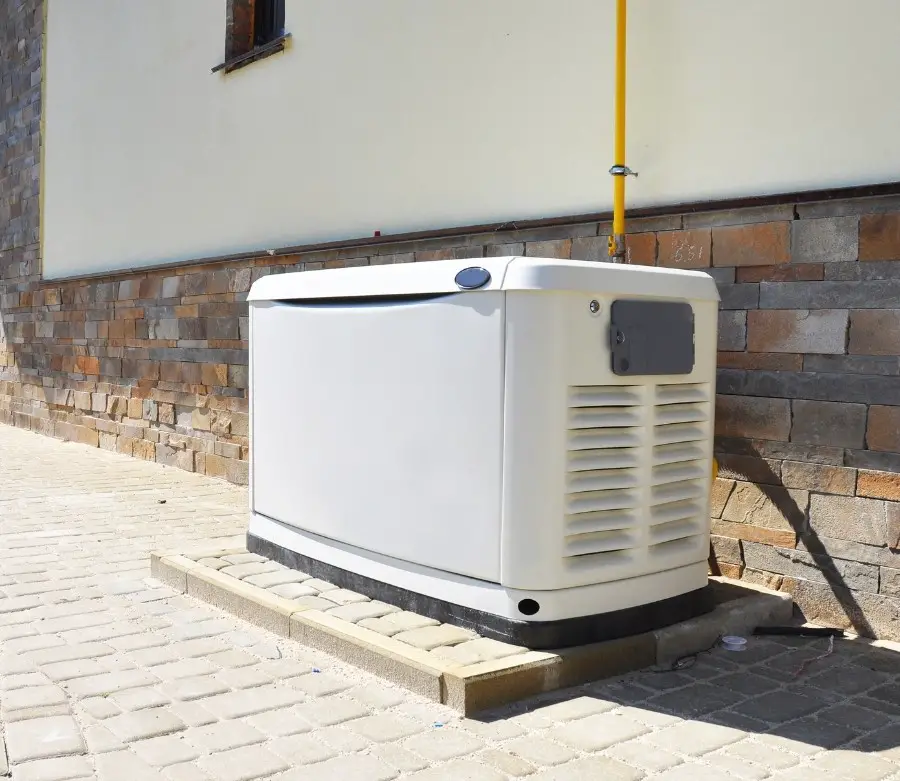
Having a good generator for your home is very important to protect you from any possible natural disasters or accidents. Finding the correct size generator for your house is important for any homeowner.
A generator too small won’t handle the wattage from your appliances, and a generator too big might be too heavy to move around
What size generator do you need for a house? The size generator needed depends on the size of the house and which appliances you want to run. A 2,000-watt generator can typically power a refrigerator and a few small electronics. The more you want to power, the more powerful the generator you’ll need.
The following will detail how to pick the best generator for your needs and explain what the different factors are for a generator. Price ranges for standby and home generators will also be given.
How to Find What Size Generator Is Needed?
Most houses can run critical appliances such as a well, refrigerator, freezer, or lights on a 5,000 to the 7,500-watt generator.
Generators’ sizes are based on the electrical output, regardless of their size, and they are measured in watts or kilowatts.
There are three simple steps to determining the correct size generator for your home, taking into account how much you need to run and how large you want the generator.
Appliance Wattage
When deciding what size generator to get, you have to consider which appliances will be running through the generator.
Make a list of all your appliances you would need to run, add the wattage together, and also add in any starting watts. With these numbers, you should have the wattage-sized generator you need.
Size
The size of the generator can matter if you plan on moving it around, and the weight of it can make a difference. Some generators can be heavy in weight and would not be ideal for moving around.
With more modern designs that have wheels and handles, it’s now easier to move and transport your generator around.
A stationary generator is very heavy and not meant to be moved around, while a portable generator does move around with ease.
Running Time
When factoring in the watts and the size of the generator, it’s also important to consider the running time – how long you want it to run between charges.
If power outages are common where you live, a generator that has a long battery life might be the best option.
Basics of Starting Watts and Running Watts
When picking a new generator, the terms starting watts and running watts might be mentioned, as well as how they affect a generator.
Starting watts are the wattage needed to start the device – what’s needed to get it to turn on. For example, starting a lawnmower takes a massive starting watt to get it running.
During this process, a brief surge is experienced, which is why other terms of surge watts or peak watts is used. The surge of power is normally between two and three seconds of extra power.
While running, watts are the wattage needed to keep the device running while it’s turned on, or how many wattages can be provided continuously.
Another name for running watts could be rated watts. Both the starting and running watts are needed to figure out the calculated wattage.
How to Calculate Wattage Needs
There is a simple math equation for figuring out how much wattage is needed:
Watts (electrical power) = Volts (voltage) * Amps (current)
This formula can figure out the watts needed. Most appliances should have this information listed and also might have the wattage information.
Voltage is the electrical potential of energy, while amps are the flow of electrical energy similar to the rate of water through a hose.
Home Standby Generator Cost
A standby generator is a great option for people that live in an area with higher power outage rates. They are installed and connected directly to the house. These do not get moved around as a portable generator could.
This type of generator can last for over 3,000 hours and typically can last for 30 years with proper maintenance.
The longevity of this type of generator does make it more expensive. It can cost between $7,000 and $15,000, not including installation and maintenance costs.
Portable Home Generator Costs
This type of generator is created to move around and be brought to different locations, making it very portable. They also tend to be much lighter and may have wheels attached to make traveling easier.
While portable generators do not last as long as standby generators, they still do have a long life of 1,000 to 2,000 hours and can run for 10 to 20 years.
These generators are also less expensive than stationary generators, costing between $200 and $5,000.
Common Household Appliance Wattage
Some of the most common household appliances that people might want to continue running during a power outage are refrigerators, lights circuits, and sometimes running water.
Each household will have its own priorities to what they feel is important to keep running.
This chart shows some of the most common household appliances and how much wattage they take while running and additional starting watts that might be needed.
| Appliance | Running Watts | Additional Starting Watts |
| Microwave | 1,000 – 2,000 watts | 0 watts |
| Refrigerator | 500 – 750 watts | 220 watts |
| Air Conditioner | 1,200 watts | 3,600 watts |
| Washing Machine | 1,800 watts | 2,250 watts |
Each person’s need for a generator is based on what appliances they might need to keep running during a power outage.
For people with a lot of frozen food, there might be a high priority to keep the freezers running. For this a stronger generator to handle the running and starting wattage may be needed.
Best Generators to Buy
Generators are a great investment for any homeowner or people who like camping and want the ability to have a power source.
Some of the best portable generators options are:
- Briggs & Stratton S3500 Portable Generator – 3,500 watts
- Honda EU2200i Portable Inverter Generator – 2,200 watts
- Champion Power Equipment 100231 – 5,500 Watts
Some of the best stationary generators include:
- Generac Guardian Series – Model 7172 – 10,000 Watts
- Cummins QuietConnect Home – Model RS13A – 13,000 Watts
- Briggs & Stratton Automatic Home – Model 040375 – 10,000 Watts
All of these generators are great options for whatever you need a generator for. Although the stationary generators are much more expensive, they could prove to be very useful in a disaster.
It’s important to take into account how much each generator costs and if you’d actually need that much wattage.
A high wattage generator will cost more, but you might not need that much energy, while a lower wattage might be perfect for your needs. This is why it’s important to calculate the amount of wattage needed.
Conclusion
Keeping the generator safe from moisture or dust and performing yearly maintenance checks are the best ways to keep your generator running and lasting as long as possible.
Regardless of whether you choose stationary or portable generators, the investment will pay off if the power keeps your food and home safe during an emergency.
Making sure you have the correct generator for your needs and the correct wattage can ensure years of successful powering!
Sources:
https://generatorbible.com/blog/starting-running-watts/
https://sciencing.com/change-electrical-amps-watts-8402123.html
https://www.alltimepower.com/learn-more/how-long-do-generators-last/
https://www.greengearglobal.com/generator-sizing/
https://www.popularmechanics.com/home/a24797353/home-generator/
